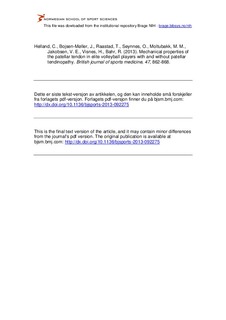Mechanical properties of the patellar tendon in elite volleyball players with and without patellar tendinopathy
| dc.contributor.author | Helland, Christian | |
| dc.contributor.author | Bojsen-Møller, Jens | |
| dc.contributor.author | Raastad, Truls | |
| dc.contributor.author | Seynnes, Olivier R. | |
| dc.contributor.author | Moltubakk, Marie M. | |
| dc.contributor.author | Jakobsen, Vidar | |
| dc.contributor.author | Bahr, Roald | |
| dc.date.accessioned | 2014-01-14T10:38:15Z | |
| dc.date.available | 2014-01-14T10:38:15Z | |
| dc.date.issued | 2013 | |
| dc.identifier | Seksjon for fysisk prestasjonsevne / Department of Physical Performance | |
| dc.identifier.citation | British Journal of Sports Medicine. 2013, 47, 862-868 | no_NO |
| dc.identifier.uri | http://hdl.handle.net/11250/171184 | |
| dc.description | I Brage finner du siste tekst-versjon av artikkelen, og den kan inneholde ubetydelige forskjeller fra forlagets pdf-versjon. Forlagets pdf-versjon finner du på bjsm.bmj.com: http://dx.doi.org/10.1136/bjsports-2013-092275 / In Brage you'll find the final text version of the article, and it may contain insignificant differences from the journal's pdf version. The definitive version is available at bjsm.bmj.com: http://dx.doi.org/10.1136/bjsports-2013-092275 | no_NO |
| dc.description.abstract | Background: Although differences in mechanical properties between symptomatic and healthy tendons have been observed for the Achilles tendon, the impact of tendinopathy on patellar tendon mechanics is not fully documented. The aim of the present case–control study was to assess the mechanical properties of the tendon and jump performance in elite athletes with and without patellar tendinopathy. Methods: We identified 17 male volleyball players with patellar tendinopathy and 18 healthy matched controls from a 5-year prospective cohort study on junior elite volleyball players. Outcome variables included three measures of maximal vertical jump performance and ultrasound-based assessments of patellar tendon cross-sectional area, stiffness and Young's modulus. Results The proximal cross-sectional area of the patellar tendon was significantly larger in the tendinopathic group (133±11 vs 112±9 mm2, respectively; p<0.001). Pathological tendons presented lower stiffness (2254±280 vs 2826±603 N/mm, respectively; p=0.006) and Young's modulus (0.99±0.16 vs 1.17±0.25 GPa, respectively; p=0.04) than healthy tendons. However, the difference between the countermovement jump height and the squat jump height (3.4±2.2 vs 1.2±1.5 cm, p=0.005) was significantly higher in the tendinopathic group compared with the control group. Conclusions: Patellar tendinopathy is associated with a decrease in the mechanical and material properties of the tendon in elite athletes subjected to a high volume of jumping activity. However, compared with their healthy counterparts, tendinopathic volleyball players have a better ability to utilise the stretch-shortening cycle when jumping. | no_NO |
| dc.language.iso | eng | no_NO |
| dc.publisher | BMJ Publishing Group | no_NO |
| dc.subject | adult | |
| dc.subject | biomechanical phenomena / physiology | |
| dc.subject | case-control studies | |
| dc.subject | elasticity / physiology | |
| dc.subject | electromyography | |
| dc.subject | exercise / physiology | |
| dc.subject | isometric contraction / physiology | |
| dc.subject | muscle, skeletal / physiology | |
| dc.subject | patellar ligament / anatomy & histology, physiology | |
| dc.subject | prospective studies | |
| dc.subject | tendinopathy / pathology, physiopathology | |
| dc.subject | volleyball / injuries | |
| dc.subject | young adult | |
| dc.title | Mechanical properties of the patellar tendon in elite volleyball players with and without patellar tendinopathy | no_NO |
| dc.type | Journal article | no_NO |
| dc.type | Peer reviewed | no_NO |
| dc.subject.nsi | VDP::Social science: 200::Social science in sports: 330::Other subjects within physical education: 339 | no_NO |
| dc.source.journal | British Journal of Sports Medicine | no_NO |
| dc.identifier.doi | 10.1136/bjsports-2013-092275 |
Files in this item
This item appears in the following Collection(s)
-
Artikler / Articles [2119]
